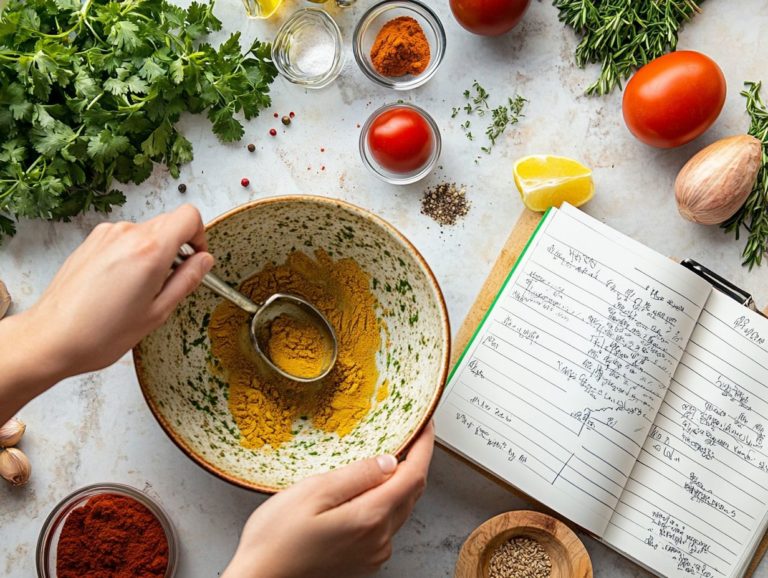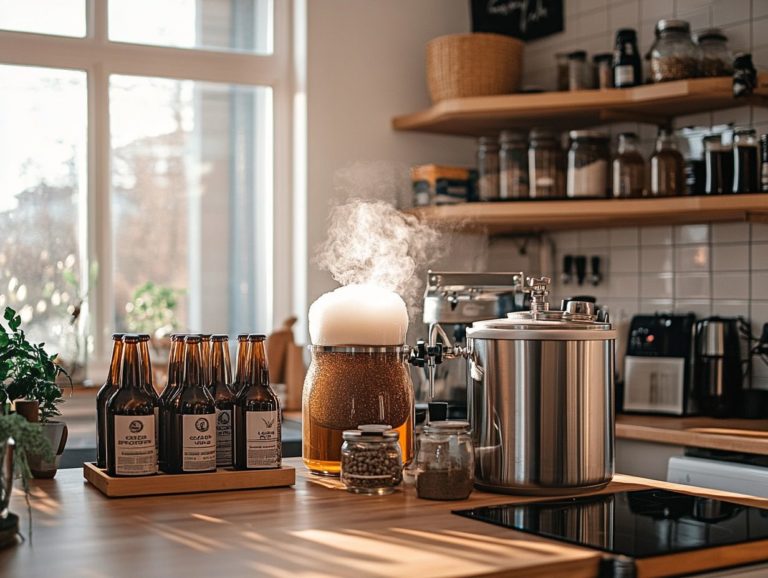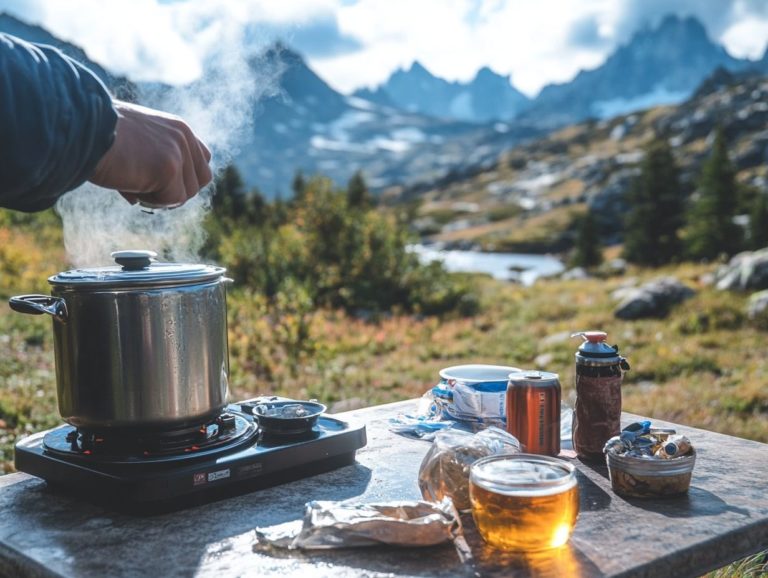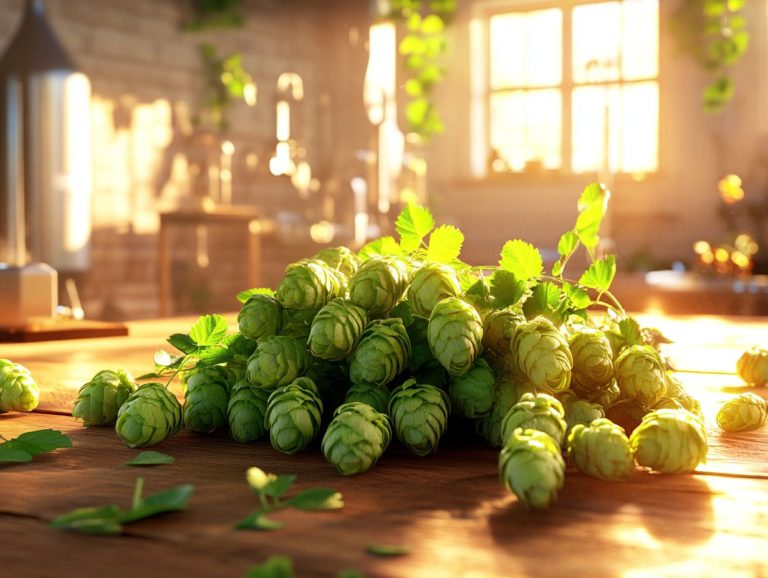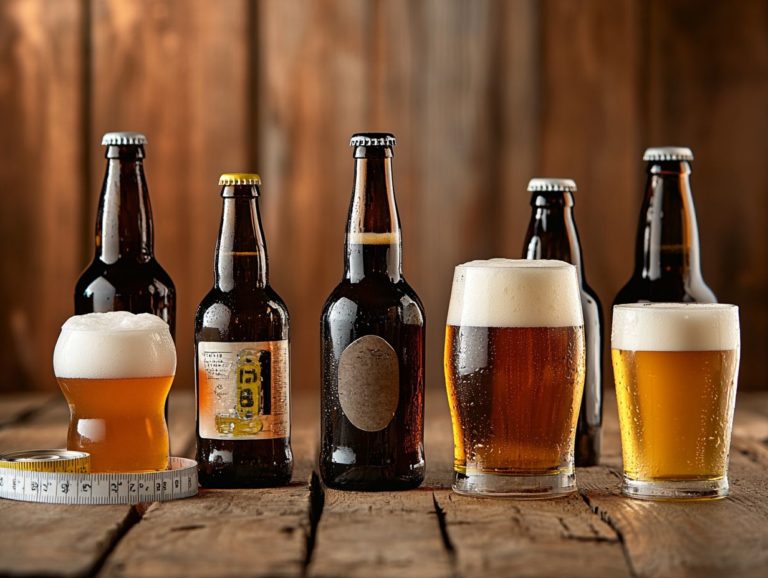How Do I Brew Seasonal Beers?
Contents
Exploring Seasonal Beers
Seasonal beers infuse the brewing world with captivating charm. Each variety embodies the distinct flavors and essence of its season. These beer styles showcase each season’s best flavors.
From the crisp, floral notes of spring beers to the rich, spiced brews of winter, get ready to discover an exciting array of seasonal beers just waiting for your taste buds! This guide will lead you through the different types of seasonal beers, the intricacies of the brewing process, and essential tips to elevate your brewing prowess. Discover how traditional beers and innovative seasonal offerings fit into your brewing schedule.
Whether you re just starting out or you ve been brewing for a while, you ll find plenty of inspiration to create your next favorite seasonal masterpiece. Use brewing tips from experienced beer writers like David Ackley of the Local Beer Blog to enhance your craft.
Key Takeaways:
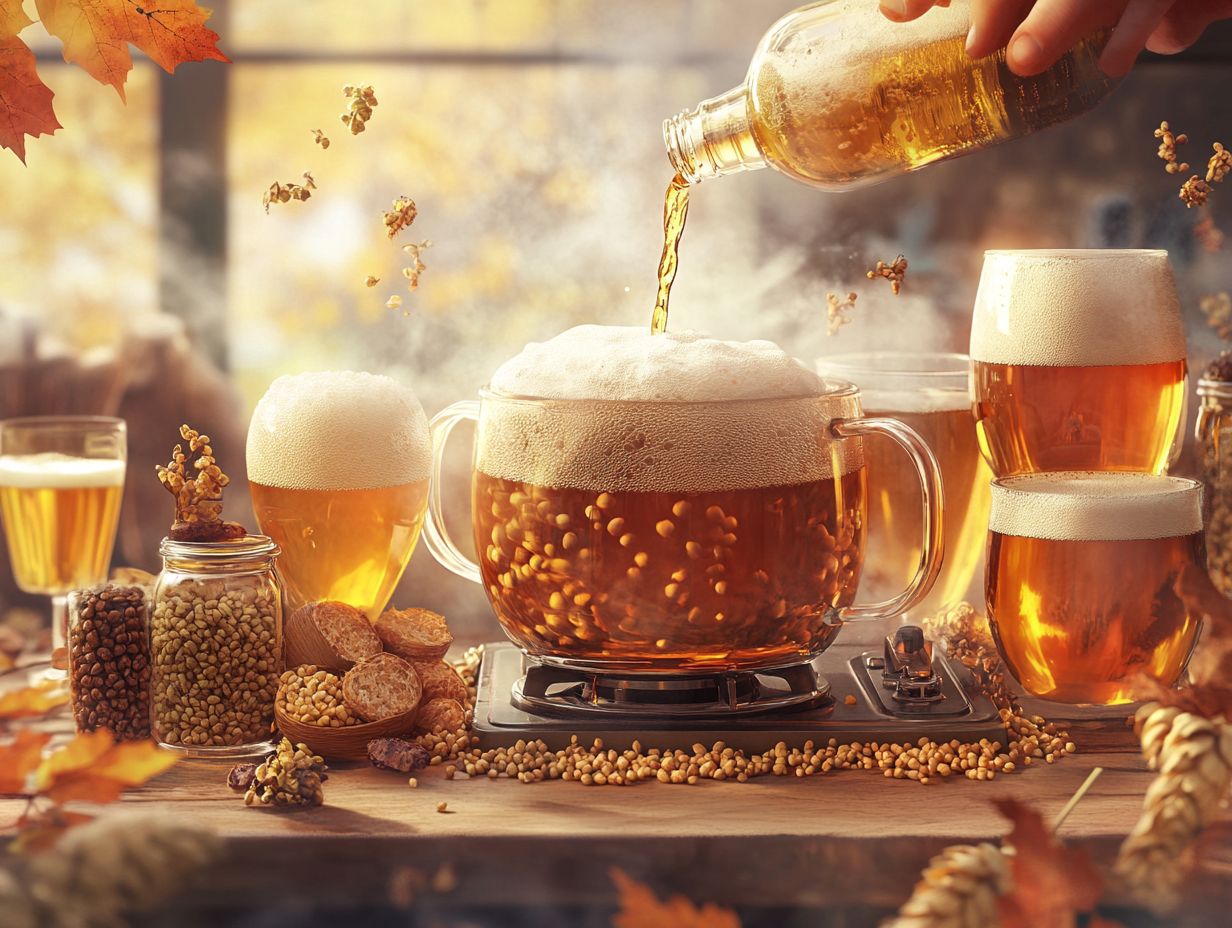
- Choose brewing recipes carefully to match the season’s flavors and styles.
- Incorporate fresh and local brewing ingredients for a true seasonal taste.
- Consider food pairings, beer glassware, and effective marketing to enhance the experience of drinking seasonal beers.
What Are The Different Types Of Seasonal Beers?
Seasonal beers represent a captivating segment of the craft beer movement, presenting you with unique flavors and styles designed for specific times of the year. Picture yourself savoring a refreshing summer ale that perfectly complements a sunny day or indulging in a rich winter ale ideal for those cozy nights. Each beer beautifully embodies the essence of its season. From light lagers to dark beers, there’s a type for every palate.
The brewing calendar invites you to explore a delightful variety of options. You’ll find Oktoberfest lagers, fruity summer ales, and robust imperial stouts. Enjoy everything from crisp lagers to hoppy pale ales, each meticulously crafted with specific brewing techniques and ingredients that elevate their seasonal charm. Even rarer beer types, like Gose or Kveik yeast beers, can find their place in the brewing seasons.
1. Spring Beers
Spring beers often showcase refreshing styles like hefeweizen and pale ales, perfectly capturing the invigorating essence of the season. These brews, celebrated for their light bodies and crisp finishes, make for ideal companions as the days grow warmer. Other styles that shine during this vibrant season include Maibock and Saison.
Hefeweizens, with their delightful fruity banana notes and clove-like spiciness, invite you to explore adventurous brewing techniques. Achieving that signature cloudy appearance requires a thoughtful balance of wheat and barley, showcasing the craft behind each pint.
Pale ales present a hoppy yet balanced profile, featuring flavors that range from zesty citrus to delicate floral notes, enhanced by the artful use of dry-hopping methods. Dry-hopping is a technique used to add hop flavors without increasing bitterness.
When you combine these styles in your recipes, they pair beautifully with seasonal dishes like grilled asparagus or lemon herb chicken. This synergy allows their vibrant flavors to shine together, creating an unforgettable culinary experience that you won’t want to miss.
2. Summer Beers
Summer beers, like light lagers and invigorating summer ales, are designed to satisfy your thirst and elevate your outdoor experiences during the sunniest months. These brews typically offer a lighter body and a crisp finish, making them perfect companions for leisurely afternoons spent soaking up the sun.
Many summer beers showcase delightful fruit-forward flavors. They incorporate ingredients such as citrus peels, tropical fruits, and even a hint of herbs, which enhance their refreshing qualities. Summer months are the perfect time to experiment with fruit beers and light lagers.
You ll often find pale malts providing a subtle sweetness that s beautifully balanced by hops, adding just the right touch of gentle bitterness. In terms of food pairings, these styles shine alongside light salads, grilled seafood, or zesty barbecue, harmonizing effortlessly with the vibrant flavors of summer cuisine.
3. Fall Beers
Fall beers, like Oktoberfest and rich amber ales, embody the essence of the season. They offer complex flavors that mirror the changing leaves and the arrival of cooler weather.
These beers often have a sweet malt flavor. Subtle hints of caramel and toffee enhance the taste, inviting you to savor each sip. Oktoberfest, with its origins rooted in the spirited celebrations of Munich, presents a bready, full-bodied malt profile. Amber ales draw from both American and British brewing traditions, reflecting a rich and diverse heritage. Fall is also a great time for robust beers like Marzen styles and Irish stouts.
Techniques such as a brewing method that involves boiling part of the mash and a process that helps clarify the beer and improve its taste elevate these flavors, resulting in a remarkably smooth finish. When you pair these autumnal favorites with seasonal dishes like roasted root vegetables or hearty stews, you create a dining experience that perfectly harmonizes with the crispness of the autumn atmosphere.
4. Winter Beers
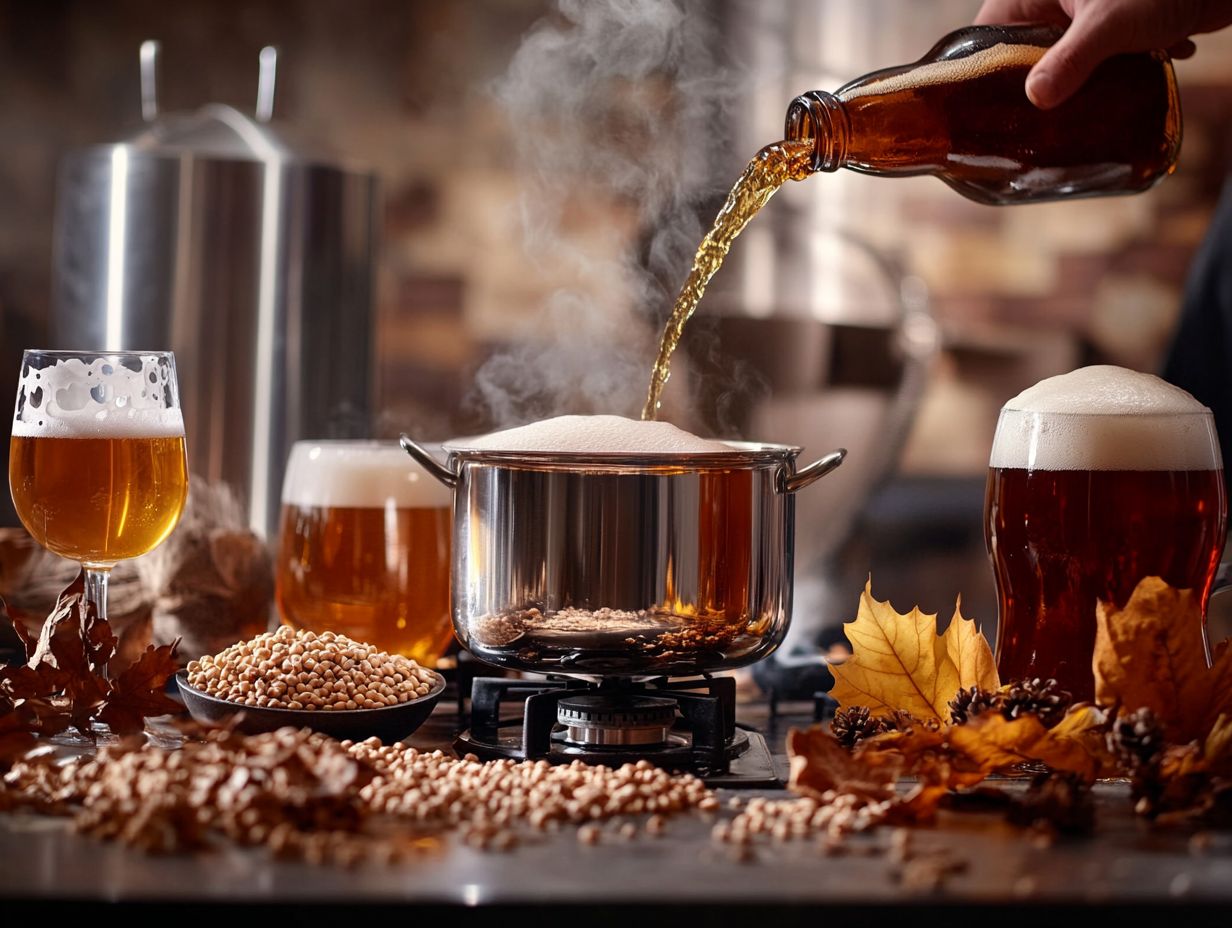
Winter beers offer a comforting embrace, filled with rich flavors found in styles like strong porters, barleywines, and festive holiday spiced ales.
These brews possess a robust character that beautifully reflects the chill of the season. They invite you to savor each sip while enjoying the festivities. Brewers masterfully employ techniques such as adding spices like cinnamon and nutmeg or using darker malts to craft depth and complexity. The winter months are perfect for brewing rich, malt-focused beers, including strong Scotch ales and holiday spiced ales.
By incorporating seasonal ingredients, winter ales capture the essence of cozy gatherings and long evenings spent by the fireplace. They pair wonderfully with hearty dishes like roasted meats, rich stews, and indulgent festive desserts like Christmas cookies, enhancing your overall experience of winter celebrations.
As both locals and visitors gather to celebrate the holidays, these unique beers foster a spirit of warmth and joy during this enchanting season.
How Do I Brew Seasonal Beers?
Brewing seasonal beers demands a keen understanding of unique recipes, precise fermentation temperatures, and techniques meticulously crafted for each specific beer type and its corresponding seasonal flavor profile. Following the brewing calendar ensures that your brewing schedule aligns with the best-of-show beer competitions and seasonal beer festivals.
1. Recipe Selection
Selecting the right recipe is essential when you’re brewing seasonal beers. Different styles call for unique ingredients and brewing methods to achieve those coveted flavors.
To truly embrace the art of seasonal brewing, consider incorporating local and seasonal ingredients that elevate the taste and capture the essence of the season. During the warmer months, fresh fruits like cherries or peaches lend a vibrant, refreshing quality to your wheat ales or IPAs. When autumn rolls around, spice-forward recipes featuring pumpkin and cinnamon evoke a cozy flavor profile, perfect for those crisp, chilly days. For inspiration, check out our crafting seasonal beer recipes for festivities. Brewing with adjuncts like honey or molasses during winter can add a layer of complexity to your beers.
Each seasonal beer you create does more than just quench thirst; it narrates a story woven from its ingredients and the time of year it represents, offering you and your guests a unique experience with every sip.
Start experimenting with seasonal ingredients today and create your own memorable brews!
2. Brewing Process
The brewing process for seasonal beers is an art, requiring specific techniques and precise fermentation temperatures that can greatly influence the flavor and aroma of the final product. Brewing techniques such as dry-hopping, the process of adding hops after boiling to enhance aroma without adding bitterness, barrel aging, and decoction mashing can significantly elevate the profile of your seasonal beers.
In the initial stages of brewing, such as mashing, you play a crucial role by converting the starches in grains into fermentable sugars. This phase lays the groundwork for the beer s character.
Then comes the boiling stage, where not only is the wort sterilized, but you also introduce hops, which add both bitterness and aromatic qualities. By adjusting the boiling time and selecting different hop varieties, you can craft an array of seasonal flavors think refreshing citrus notes in summer ales versus rich, spicy undertones in winter brews. Balancing hop bitterness with malt sweetness is crucial in styles like Pilsner and Belgian ales.
The fermentation process is equally vital. By experimenting with varying yeast strains and fermentation temperatures, you can create a spectrum of flavors, from fruity esters to robust malty profiles, each reflecting the essence of the season.
3. Fermentation and Conditioning
Fermentation and conditioning are pivotal stages in the brewing of seasonal beers, enabling the creation of the intricate flavors and aromas that define each unique style.
Your choice of yeast is crucial, as different strains contribute distinctive characteristics think fruity esters or spicy phenols that enhance the beer s overall profile. It s essential to maintain optimal temperature control during fermentation. While warmer temperatures may speed up the process, they can also lead to unwanted flavors. Cooler conditions, on the other hand, help cultivate a more refined taste.
Exploring various conditioning methods, such as barrel aging, the use of adjuncts, or dry-hopping, can elevate the beer s complexity significantly. These methods add layers of flavor that resonate beautifully with each seasonal release. For unique flavors and aromas, consider using Kveik yeast for spring and summer beers.
By understanding these processes, you empower yourself to craft exceptional seasonal offerings that truly captivate enthusiasts.
4. Packaging and Labeling
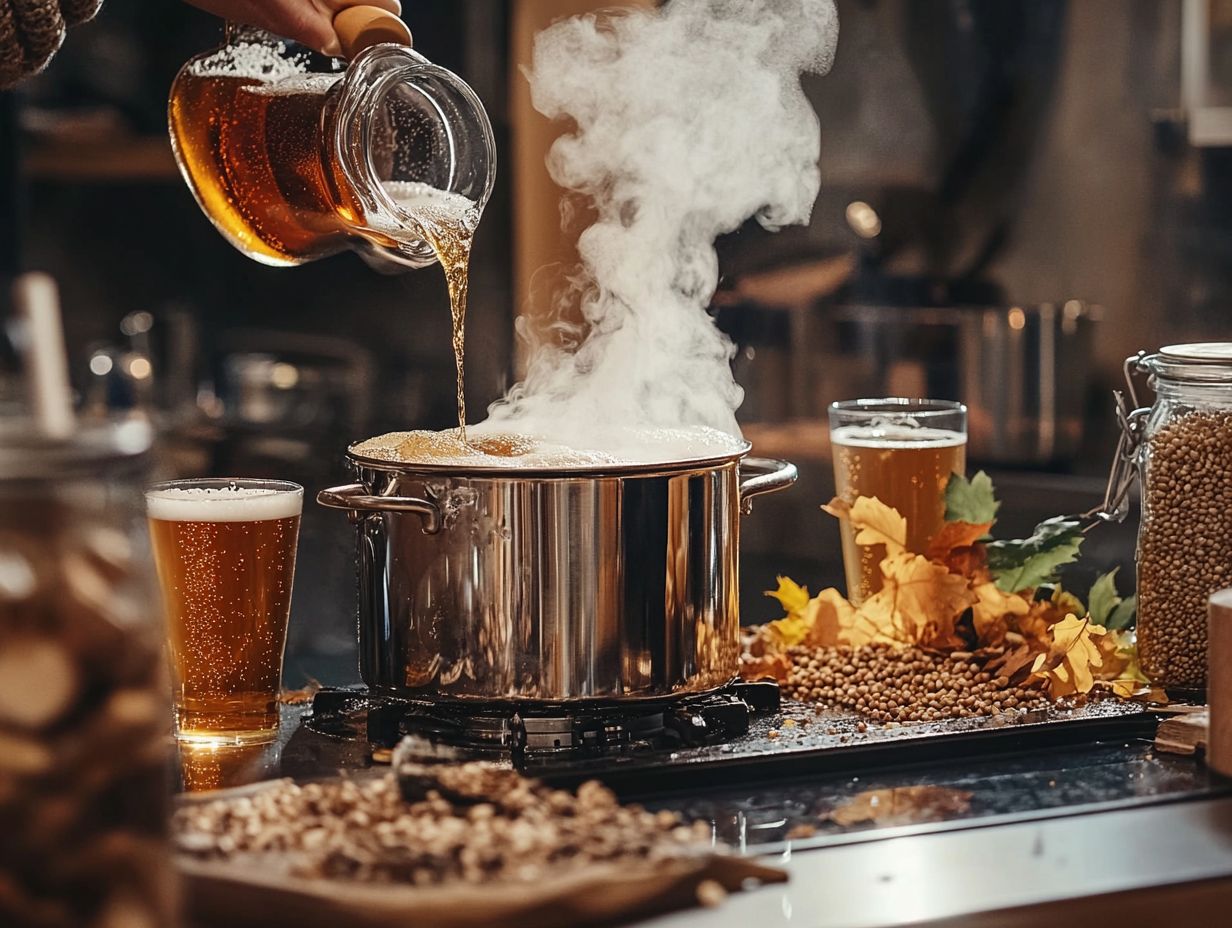
Effective packaging and labeling are vital for your seasonal beers; they not only protect your product but also communicate the unique characteristics and story that each craft beer holds.
This visual branding is essential for capturing consumer attention, especially during seasonal transitions when competition is at its peak. Thoughtful design choices like vibrant colors, distinctive typography, and striking imagery can forge an emotional connection with customers who crave something new and exciting. Effective labeling can make your beer stand out in competitions and among a myriad of other seasonal beers.
If you’re a brewery entering beer competitions, innovative packaging can set your offerings apart. It showcases your creativity while meeting industry standards. Think creatively with eco-friendly materials or interactive designs to boost your appeal. Adhering to your brewing calendar helps you plan and innovate effectively.
By aligning your visual strategies with seasonal themes, you can effectively attract consumers eager to indulge in your limited-time brews. Traditional beer styles like Oktoberfest and Maibock can be focal points in your marketing plans.
Tips for Crafting Exceptional Seasonal Beers
When you brew seasonal beers, utilizing effective brewing tips can significantly elevate the quality and enjoyment of each batch. This approach allows you to connect deeply with local flavors and seasonal offerings, enhancing your brewing experience and delighting your palate. Leveraging brewing techniques specific to the season can further refine your creations.
Don’t miss out on these essential tips to elevate your seasonal brewing to the next level!
1. Experiment with Flavors
Experimenting with flavors is essential for you as a brewer when crafting seasonal beers. This process helps you craft unique offerings that stand out in the competitive craft beer market. Brew beer styles like barleywine or hefeweizen to add variety to your lineup.
Incorporating spices like cinnamon and nutmeg, along with fruits such as cherries and oranges, infuses depth and complexity into your creations. Imagine elevating your seasonal brews with unconventional ingredients chili peppers or even herbs like basil. These can transport your beer to unexpected heights, offering a multi-dimensional tasting experience. For those seeking robust profiles, imperial stout with added spices can be a winning combination.
Check out exciting examples like pumpkin ales, brewed with a harmonious blend of spices that evoke the essence of autumn, or summer wheat beers invigorated with fresh citrus, transforming them into lively, refreshing choices. You might also explore Christmas ales or Gose for diverse seasonal experiences.
Such innovations encapsulate the spirit of the seasons and captivate beer enthusiasts seeking something beyond the ordinary. Creating a unique holiday spiced ale can amaze and enchant your audience during the festive season.
2. Use Fresh and Local Ingredients
Incorporating fresh and local ingredients into your seasonal brewing enhances the flavor profile and champions the craft beer movement. For example, Kveik yeast, a traditional Norwegian yeast, adds unique character to your beers, aligning with the innovative spirit of craft brewing.
When you choose locally sourced components, you tap into the rich flavors of native grains, fruits, and herbs. This creates brews that truly reflect the agricultural bounty of your region. This approach elevates the taste and aroma of your final product and guarantees exceptional freshness. Leveraging brewing ingredients from local sources makes all the difference.
By sourcing local ingredients, you support the local economy and nurture community connections, as breweries team up with nearby farms and suppliers. Visit local farmers’ markets to discover what s in peak season. This exploration lets you experiment with brewing methods that spotlight these fresh flavors.
Engaging with local producers offers valuable insights into the characteristics of various ingredients, paving the way for innovative and delightful beers that deeply resonate with craft beer enthusiasts.
3. Consider Food Pairings
Considering food pairings is essential when brewing seasonal beers. The right combinations can elevate your tasting experience and highlight the unique qualities of each beer style.
Take a winter stout, for instance. Its rich and roasted flavors pair beautifully with hearty dishes like beef stew or dark chocolate desserts. This creates a delightful balance that tantalizes the palate.
As spring arrives, light and zesty beers like saisons can be perfectly complemented by fresh salads or lemon-herb grilled chicken. These pairings enhance the beer s citrus notes and refreshing essence.
To truly savor these pairings, organize tasting events. Imagine your guests sampling various seasonal beers alongside thoughtfully curated dishes and exploring how different ingredients dance together.
These gatherings offer a fantastic opportunity to educate attendees about the ingredients in each beer and the culinary choices that enhance the overall experience. Discussing specific beer glassware for each style can further enhance the tasting experience.
4. Label and Market Effectively
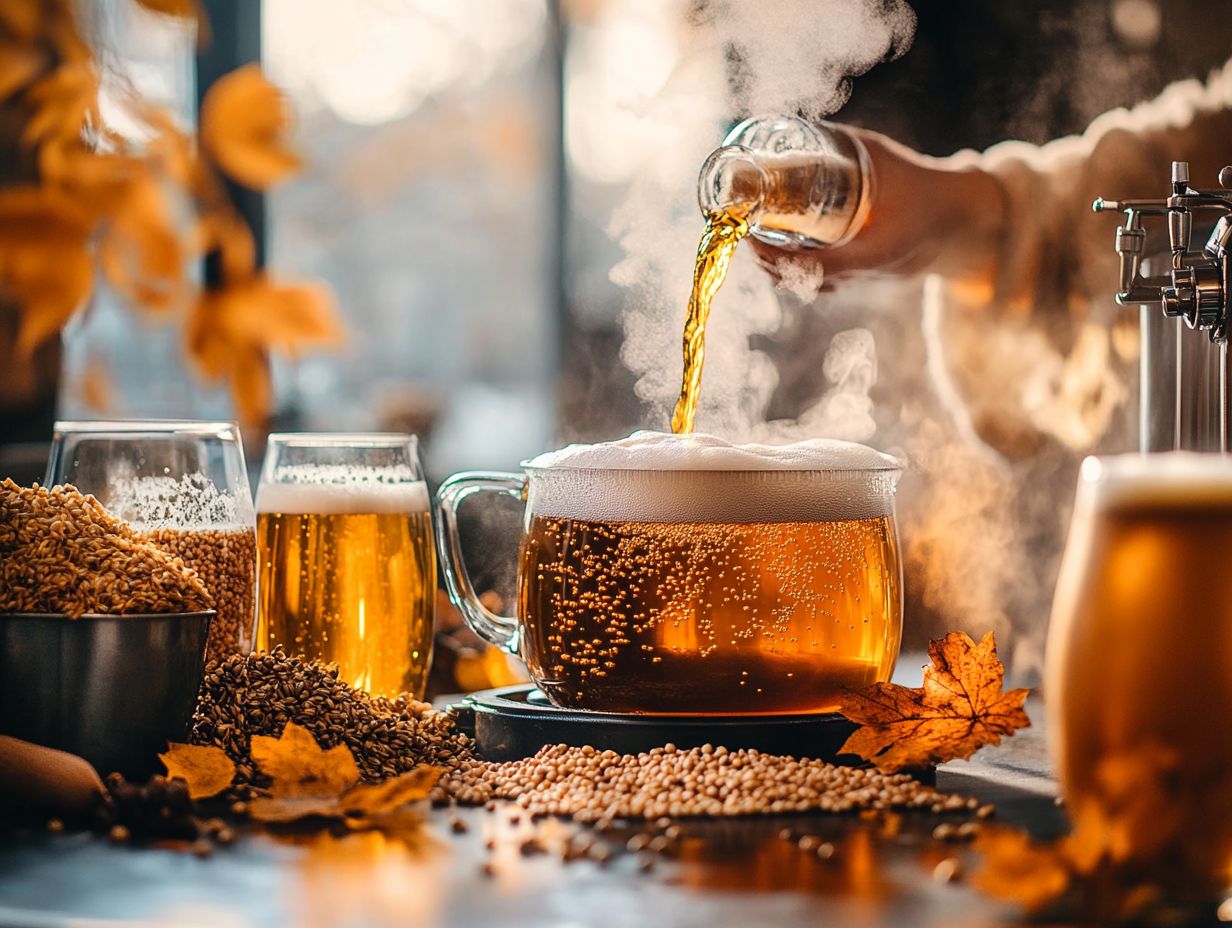
Effective labeling and marketing strategies are essential for the success of seasonal beers, as they draw in consumers and convey the unique allure of each brew. Highlighting different beer styles like pale ale or amber ale can attract a wider audience.
To truly captivate a diverse audience, you should leverage the power of storytelling that resonates with the seasons. This could range from sharing the rich heritage of the brewing process to crafting whimsical tales about the ingredients used. Eye-catching design elements play a significant role here; vibrant colors that reflect the seasonal vibe and unique bottle shapes help your products stand out on crowded shelves. For example, sharing the story behind a Maibock or Bock brew can evoke the essence of spring and winter respectively.
Promotional events, such as seasonal tastings or themed festivals, offer an engaging platform for consumers to sample the beers and connect with their narratives. By weaving these elements together, breweries not only showcase their products but also enhance their brand identity, fostering lasting relationships with customers. Organizing events around brewing seasons such as St. Patrick’s Day or Christmas can also be effective.
Frequently Asked Questions
What are seasonal beers?
Seasonal beers are beers that are brewed to reflect a particular season or time of year. They often have unique flavors and ingredients that are associated with that season. Examples include Oktoberfest in autumn or Maibock in spring.
How do I choose which seasonal beer to brew?
When deciding on a seasonal beer to brew, consider what flavors and ingredients are commonly associated with that season. For example, a pumpkin ale is a popular fall seasonal beer. You might also consider a winter stout for colder months or a summer ale for the warmer season.
What ingredients are commonly used in seasonal beers?
The ingredients used in seasonal beers vary depending on the season. For example, fall beers often use pumpkin, spices, and caramel malts, while summer beers may use citrus fruits and wheat. Winter ales might feature holiday spiced ales with nutmeg and cinnamon, while spring beers could include herbs like basil.
Do I need special equipment to brew seasonal beers?
No, you can use the same equipment to brew seasonal beers as you would for any other type of beer. However, some seasonal beers may require additional ingredients or steps in the brewing process. Monitoring fermentation temperatures and adjusting hop bitterness accordingly can also be crucial.
How long does it take to brew a seasonal beer?
The time it takes to brew a seasonal beer can vary depending on the specific recipe and brewing process. However, on average, it can take anywhere from 4-6 weeks from start to finish. Planning your brewing schedule around seasonal demands can ensure timely production.
Can I brew a seasonal beer during any time of the year?
Yes, you can brew a seasonal beer at any time of the year. However, it is recommended to brew them closer to their associated season for the freshest and most authentic flavors. For example, brewing Christmas ales in late fall ensures they are fresh for the holiday season.

